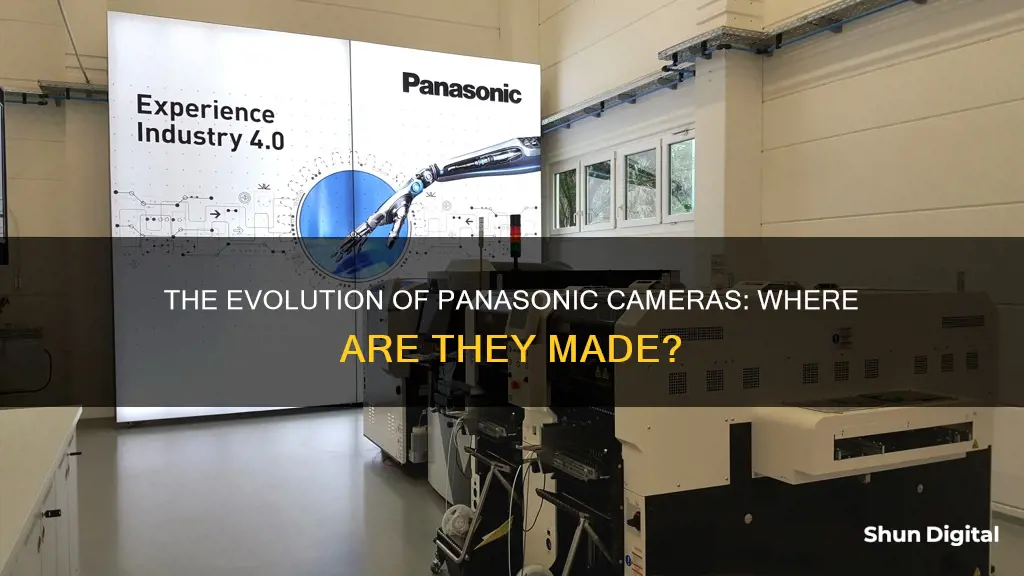
Panasonic is a Japanese multinational electronics company headquartered in Osaka, Japan. It was founded in 1918 and has since grown to become one of the world's largest makers of consumer electronics, offering a wide range of products and services. In recent years, Panasonic has faced increasing competition from Chinese rivals in the surveillance camera market, leading to a spin-off of its security camera business. The company also reportedly considered selling its Chinese security camera factory in Suzhou due to disappointing sales outside Japan.
In addition to security cameras, Panasonic manufactures a range of other camera types, including digital cameras and camcorders. The company has a lens factory in Yamagata, Japan, established in 1982, which produces glass and plastic aspherical lens elements. This factory is highly automated, utilising precision glass moulding to achieve tight tolerances and high-quality optics.
However, there have been reports that Panasonic may exit the camera business, with the company facing challenges in multiple divisions and undertaking structural reforms to improve profitability.
What You'll Learn
- Panasonic's camera factory in Suzhou, China, was sold due to disappointing sales outside of Japan
- Panasonic's Yamagata Lens Factory in Tendo City, Yamagata, Japan, manufactures glass aspherical elements from 1 to 75 mm in diameter
- Panasonic's headquarters are in Kadoma, Osaka, Japan
- Panasonic's camera market share is currently around 4.4%
- Panasonic's camera division has been removed from the company's mainstream maintenance

Panasonic's camera factory in Suzhou, China, was sold due to disappointing sales outside of Japan
Panasonic is a Japanese multinational electronics company, founded in 1918 by Kōnosuke Matsushita. In 2008, it changed its name to Panasonic Corporation. The company has a wide range of products and services, including rechargeable batteries, automotive and avionic systems, industrial systems, as well as home renovation and construction.
In March 2018, Panasonic considered selling its security camera factory in Suzhou, China, due to disappointing sales outside of Japan. The company reached out to potential buyers, including the Carlyle Group, Permira, and CVC Capital Partners, and expected to gain over 50 billion yen ($468 million) from the sale.
The decision to sell the Suzhou factory was part of Panasonic's strategy to strengthen its security systems business and focus on its key businesses, such as automotive batteries. The company was also aiming to reduce its dependence on Tesla, with which it had an exclusive partnership for battery cell supply for the Model 3 sedan. By selling the Suzhou factory, Panasonic could invest in other areas and improve its competitiveness in the market.
The Panasonic camera factory in Suzhou, China, was put up for sale due to disappointing sales outside of Japan, and the company's desire to focus on its core businesses and improve overall competitiveness.
GoPro Cameras: Can They Support Wi-Fi Client Mode?
You may want to see also

Panasonic's Yamagata Lens Factory in Tendo City, Yamagata, Japan, manufactures glass aspherical elements from 1 to 75 mm in diameter
The factory is highly automated, achieving tolerances and quality that were previously unavailable in cine lenses. The factory's 484 employees work with machines that can create fewer elements but with higher precision. The factory uses precision glass moulding to form lens elements. This involves using a mould made from a very hard, heat-resistant material, which is finished by hand by highly skilled technicians to tolerances better than 1 micron. This process eliminates any ridges or textures that might contribute to the "onion ring" bokeh effect. Once the mould is ready, blanks of glass are heated until they soften and become malleable, at which point the moulds are squeezed together under high pressure to form the finished lens element. This process takes a matter of seconds, whereas traditional polishing can take hours.
Panasonic's Yamagata factory manufactures glass aspherical elements from 1 to 75 mm in diameter and plastic aspherical elements from 2 to 38 mm in diameter. The factory also has a 3D Profilometer that can measure to 0.1 microns (1/10,000 mm). Each lens is cleaned and hand-inspected, with advanced lenses manually finished by skilled craftspeople. The factory's quality assurance is certified by Leica.
Understanding Camera Raw's Unique Circular Slider
You may want to see also

Panasonic's headquarters are in Kadoma, Osaka, Japan
Panasonic is a multinational Japanese electronics company with its headquarters in Kadoma, Osaka, Japan. The company was founded in 1918 by Kōnosuke Matsushita as Matsushita Electric Housewares Manufacturing Works in Fukushima, Osaka. In 1935, it was incorporated and renamed Matsushita Electric Industrial Co., Ltd. The company changed its name to Panasonic Corporation in 2008 to conform with its global brand name.
Panasonic's headquarters in Kadoma, Osaka, is responsible for guiding the company's growth strategy and ongoing business evolution. The company has a primary listing on the Tokyo Stock Exchange and is a constituent of the Nikkei 225 and TOPIX 100 indices. It also has a secondary listing on the Nagoya Stock Exchange.
In addition to consumer electronics, Panasonic offers a wide range of products and services, including rechargeable batteries, automotive and avionic systems, and industrial systems. The company has operations and subsidiaries worldwide, including in North America, Europe, and Asia.
The Panasonic Corporation of North America, based in Newark, New Jersey, is a leading technology partner and integrator in the region. It is committed to sustainability and has earned LEED certifications for its headquarters, recognizing its improved environmental performance, energy efficiency, and sustainability.
Panasonic's global reach and diverse range of products and services make it a well-known and influential company in the electronics industry.
Xfinity Cameras: Who Makes Them?
You may want to see also

Panasonic's camera market share is currently around 4.4%
Panasonic is a Japanese multinational electronics company that was founded in 1918 and is headquartered in Osaka, Japan. The company has a wide range of products and services, including cameras, and currently, its camera market share is around 4.4%.
Panasonic's camera market share has seen fluctuations over the years, and while it is currently at 4.4%, the company has introduced several breakthrough technologies to the camera market through its pioneering cameras. For instance, the Panasonic GH4 was the first mirrorless camera to record in 4K/30p, and the Panasonic DMC-FZ1000 was the first camera to combine bridge super-zoom and the ability to record in 4K. Additionally, the Panasonic DC-S1H was the first mirrorless camera with a full frame to be Netflix-approved.
The company's camera market share can be attributed to its range of well-known cameras, including the Lumix GH5, Lumix S1R, Lumix G9, Lumix FZ1000 II, and Lumix ZS100/TZ100. These cameras have helped Panasonic gain a foothold in the camera market, especially in the mirrorless camera segment, where it holds a 5.5% global market share.
Panasonic's camera market share of 4.4% places it behind competitors such as Canon, Sony, and Nikon, who have larger market shares. However, Panasonic continues to innovate and expand its product offerings, aiming to capture a more significant portion of the camera market in the future.
Defringing in Camera Raw: A Step-by-Step Guide
You may want to see also

Panasonic's camera division has been removed from the company's mainstream maintenance
Panasonic, a Japanese multinational electronics company, has undergone several restructurings over the years. In 2022, the company announced a reorganization plan that split it into Panasonic Holdings Corporation and converted its divisions into subsidiaries. This included the Lifestyle Updates Business Division, which took on the Panasonic Corporation name.
In October 2016, a Japanese website reported that Panasonic may exit the camera business, similar to what Olympus had done. The report suggested that Panasonic Entertainment & Communication, responsible for TVs and digital cameras, had been removed from Panasonic Corporation, which handles home appliances and electrical materials. This move signalled a potential end to non-competitive businesses, with digital cameras being one of them.
However, Panasonic denied rumours of scaling back its camera production in 2017, stating that any changes were intended to "strengthen" camera production rather than dismantle it. The company clarified that the digital imaging segment was not being dismantled but would be moved under the umbrella of a larger division, with a potential headcount reduction.
Panasonic's camera market share has been relatively low, hovering around 4.4%. The company's marketing message has also been criticised for failing to attract entry-level users and build them up through the product range. Additionally, Panasonic's customer service has been described as a "deal-breaker" by some users.
While Panasonic continues to produce cameras, the removal of its camera division from mainstream maintenance indicates a shift in focus away from this business area.
Charging the 808 Camera: Long First Charge Needed?
You may want to see also
Frequently asked questions
Panasonic is a Japanese multinational electronics company, founded in 1918 and headquartered in Osaka, Japan. The company has factories in various countries, including Japan, China, and Malaysia. In 2017, Panasonic reported that its subsidiary Panasonic Avionics Corporation, a supplier of in-flight entertainment and communication systems, was under investigation by American authorities.
Yes, Panasonic has a security camera factory in Suzhou, China, which was reportedly up for sale in 2018 due to disappointing sales outside Japan. However, as of 2019, Panasonic continued to operate its security camera business in China through a partnership with Polaris Capital Group.
It was reported in 2021 that Panasonic may exit the camera business, similar to Olympus. The company's camera market share at the time was around 4.4%, and it was facing challenges in its TV and housing businesses. However, there have been no further announcements regarding Panasonic exiting the camera business as of 2024.







